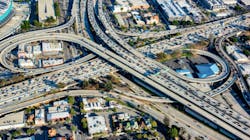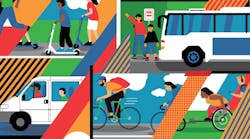OP-ED: The cost of not having choices
Robin Mazumder, Ph.D., a neuroscientist who studies the effect cities have on our well-being, says our cities and towns are addicted to cars. I agree.
This prioritization of private cars is reflected constantly in how we allocate space and resources. As Mazumder says, it's like pressing a “beg button" for permission to cross the street or riding in a precarious unprotected bike lane surrounded by zooming cars. All of this infrastructure provides the context in which people make their decisions, and they see no other choice but to take their car.
How we currently design our cities and towns to prioritize private cars over people reduces our mobility options and creates problems for the planet’s climate, societal equity and household budgets. Our roads and road networks, our sidewalks (when they exist), the parking available on nearly every street, the swaths of asphalt around malls and stadia, the driveways and vehicle entrances and the massive highway systems signal to us to “take the car, it’s the most convenient way to get around," or, even more insidiously, “You need to have your own private car to function in this city.”
Perpetuating the need to own a private car is detrimental to our planet and our society. The transportation sector generates 30 percent of U.S. carbon emissions. Even if everyone shifted all their personal cars to electric ones, the economic and environmental impacts wouldn’t be enough to move the needle on reducing carbon emissions and increasing road safety.
More than 35,000 people die each year in road crashes. Black pedestrians are struck and killed twice as often as non-Hispanic white people, and Native Americans are stuck and killed four times as often. More of those victims were elderly and more were from low-income communities. The number of people who died from vehicle crashes in 2021 in the U.S. was nearly 43,000, a 16-year high. By all indications, 2022’s numbers might be even higher.
Meanwhile, the costs of new car ownership are at historic highs. Unsurprisingly, according to a study done by the Ford School at the University of Michigan, a quarter of all adults in the U.S. experience transportation insecurity and getting your own car to address that insecurity can lead to a vicious spiral of more poverty and more insecurity. Julie Livingston and Andrew Ross, authors of Cars and Jails: Freedom Dreams, Debt and Carcerality, say that “for many low-income and minority Americans, automobiles have been turbo-boosted engines of inequality, immobilizing their owners with debt, increasing their exposure to hostile law enforcement, and in general, accelerating the forces that drive apart haves and have-nots.”
We’ve given preferential treatment to private cars over other transit modes by standardizing road signs, lane widths and even pavement quality. We’ve also made building more road access and more parking a default requirement in our development projects for much of the last century—all to benefit private car use. If we want more transportation options to compete with the private car, we should also standardize the components of shared mobility in transportation infrastructure.
This is where the Shared Mobility 2030 Action Agenda comes in—a to-do list to create more options and establish healthier, more affordable communities and mobility systems that are built around people, and the first item on the agenda is to rethink what transportation infrastructure looks like, and who it serves.
That means providing more public transportation like rail and bus infrastructure, but also more sidewalks and protected bike networks. It means expanding and supporting shared options such as on-demand transit, bike shares and scooter shares, ride hail and car sharing. It means making mobility hubs everywhere, so people know they have other choices in ways to get around.
Imagine by 2030, our transportation infrastructure prioritizes people instead of cars. Imagine we build infrastructure and services designed to reduce transportation insecurity, address equity and decarbonize transportation.
We believe that together, we can change our approach to how we invest in and build infrastructure. Together, we can create new standards that make shared mobility more reliable, easier to use, more available, more equitable and accessible, more environmentally sustainable and more economically sustainable than driving a car.
--------------
Benjie de la Peña is CEO of Shared-Use Mobility Center.

Benjie de la Peña | CEO, Shared-Use Mobility Center (SUMC)
Benjie de la Peña is the CEO of the Shared-Use Mobility Center; he chairs the Global Partnership for Informal Transportation; founder of Agile City Partners; and writes and curates Makeshift Mobility, a fortnightly newsletter covering innovations in informal transportation. He also convenes the Shared Mobility 2030 Action Agenda and edits and produces Pop Transport.
He serves on the board of the American Council for an Energy-Efficient Economy (ACEEE), the U.S. Advisory Committee of the Institute for Transportation and Development Policy, the UITP Informal Transportation Working Group, the Digital Transport for Africa Partners Committee, the MobiliseYourCity Steering Committee and is a senior fellow for mobility for the Canadian Urban Institute.
He served as the first-ever chief of strategy and innovation for the Seattle Department of Transportation. He and his team drafted the city’s Transportation Information Infrastructure Plan. He also led the development of Seattle’s New Mobility Playbook.
He served on the advisory committees for L.A.’s Transportation Technology Strategy, the Mobiprize and Cooper Hewitt Museum’s The Road Ahead: Reimagining Mobility and Design with the Other 90%: Cities.




